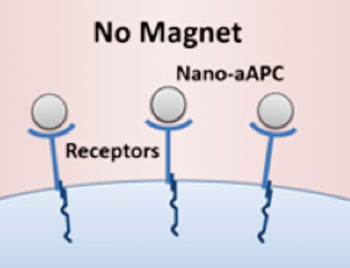Promising Cancer Immunotherapy Method Relies on Artificial Magnetic Antigen Presenting Cells
By LabMedica International staff writers
Posted on 27 Jul 2015
Cancer researchers have developed a method based on magnetic nanoparticles that enables the rapid extraction, enrichment, and expansion of a T-cell population that shows great promise as a tool for immunotherapy.Posted on 27 Jul 2015
Adoptive immunotherapy can induce long term tumor regression, but widespread adoption of this approach has been limited by the cost and complexity of generating tumor-specific T-cells.
Investigators at Johns Hopkins University (Baltimore, MD, USA) developed an improved method for generating tumor-specific T-cells to use for adoptive immunotherapy. Their method employed paramagnetic, nanoscale artificial antigen presenting cells (aAPC) to rapidly expand tumor-specific T-cells from rare naïve precursors.
Thus far, aAPCs have been synthesized by coupling T-cell activating proteins such as CD3 or MHC-peptide to micron-sized beads. Nanoscale platforms have different trafficking and biophysical interaction properties and may allow development of new immunotherapeutic strategies. Thus, for the current study, the investigators manufactured aAPCs from biocompatible iron-dextran paramagnetic particles (50–100 nanometers in diameter).
Details of the methodology were present in a paper published in the July 14, 2015, online edition of the journal ACS Nano. The investigators mixed blood plasma from mice and, separately, humans with magnetic aAPCs that had been coated with tumor antigens. The plasma was passed through a magnetic column, and T-cells adhered to the aAPCs and were retained on the column. Other types of cells were washed through the column and discarded. The magnetic field of the column activated the T-cells, which were then washed off and cultured. After one week, their numbers had expanded by an estimated 5,000 to 10,000 times.
Senior author Dr. Jonathan Schneck, professor of pathology, medicine, and oncology at Johns Hopkins University, said, “The challenge has been to train these cells efficiently enough, and get them to divide fast enough, that we could use them as the basis of a therapy for cancer patients. We have taken a big step toward solving that problem.”
Related Links:
Johns Hopkins University















